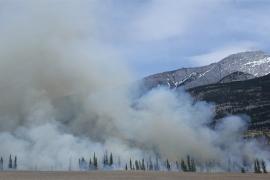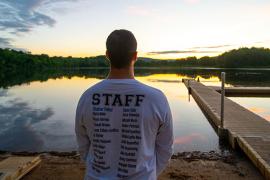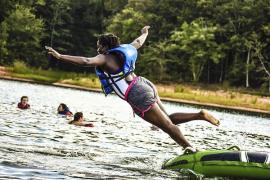One of the unique challenges and opportunities of staffing a summer camp is that a new team and culture are built every year. Some returning staff or former campers may be in the lineup, but largely the ingredients are different, allowing you to enhance the recipe you’ve used in the past to make something fresh and new.
If you are a camp professional, you understand safety is paramount. But with so little time and so much training needed, how do you develop a safety mindset beyond the leaders at the top? Directors are expert architects of camp culture. You understand the power of hiring the right people, providing purposeful work, creating healthy and positive experiences, and forming meaningful connections. A continuous thread of safety must be woven into your efforts to design and refresh your camp culture. Without safety holding everything together, you can jeopardize your ability to create the impact your camp sets out to make.
You can google hundreds of tips on creating workplace safety, but as camp professionals, the hack is merging your camp culture with a safety mindset. These are 10 tips to help you enhance the safety mindset and boost your camp culture at the same time.
1. Create awareness of the realities from the start.
Put safety front and center from the start. Marketing and recruitment materials should highlight your focus on safety. Your screening and hiring processes should include questions that promote discussion about safety. As you share your mission with prospective staff and the impact you hope to make, you must also share that none of this can be realized unless everyone is focused on safety.
Move beyond just thinking about how you will prevent abuse, accidents, and injuries in camp to spark discussion that starts in the hiring process. Ask applicants how they might take action to prevent abuse, accidents, and injuries in their role.
2. Embrace storytelling.
It was 5:00 a.m. when a group of campers and staff loaded up the SUVs to drive the winding road out of camp and down to the beach for their daily surf lesson. I lay sleeping in my cabin, with the radio set to full volume about six inches from my pillow. A call came in and blasted me out of bed. “A vehicle went over the . . . ” (then silence). My shoes were already on and I was running out my door. Another call slowly followed. “Never mind” (then silence again), followed by a quick call saying, “ . . . IT’S AN EMERGENCY.”
It turned out that none of the staff on the trip had ever actually used the radio to this point. They couldn’t remember the radio protocols and clearly fumbled their communication. It wasn’t an emergency: one tire of a vehicle was stuck in soft sand, and they couldn’t get it out.
Stories are the most powerful way to unlock your staff and even campers’ connection to learning about safety. Stories stick. They are easy to remember. Policies on a page just don’t have that same staying power. When I told this story, it piqued their interest and got them to pay attention to the policies. But it also made them practice and better understand what they were accountable for when using a radio. During training, you likely have piles of your own lessons learned and scenarios you can spin into stories that staff crave and will aid in their rapid learning. Everyone feels the connection from a good camp story.
3. Create a we and overturn us vs. them.
Whose job is it anyway? Unless you are clear from the start that safety is a we issue, there is a risk of seasonal staff misunderstanding their accountability. Leadership might manage specific safety tasks, but safety is strongest when everyone equally contributes to minimizing accidents and injuries. This helps build trust and team alignment.
4. Authority of advocacy.
Empowering staff and campers to advocate for safety is an excellent way for them to practice and build transferable skills. Staff need to feel psychologically safe to advocate in a meaningful way. This means their supervisors must be open to dialog on their ideas or input. Sometimes advocacy shows up as complaints, which have a common thread of something being unsafe or someone feeling uncomfortable. Being open to their insights can build the respect and trust needed for the next step to be effective, too.
5. See something, say something.
This framework is frequently introduced around abuse prevention and harm reduction. But the concept is powerful in reminding staff of their responsibility and power in ALL matters of safety. In their training period and beyond, develop their lens to identify hazards of all kinds and how they can share those hazards so action steps can be taken.
Want an easy exercise to get them in practice? Divide into small teams with a simple checklist of typical safety concerns and have them cover a concentrated area of camp. This might not be part of your daily routine but getting a bunch of eyes to make observations with a lens for safety will carry with them through the rest of the summer.
6. Learning by sharing near misses.
We pay too little attention to the near misses that happen each summer, but this is where an abundance of learning and prevention can take place. Teaching staff to identify near misses and providing a process to report them creates a learning lab at camp. Staff can engage in prevention and foster changes to be a real part of solutions.
7. Understanding layers.
There is not a magical stand-alone safety rule, but rather a compilation that creates layers of protection. For example, we gather information from parents/guardians about a camper’s swimming ability, we conduct a swim skill check and assign swimming areas and functions based on this information. No one thing is strong enough on its own, but all the layers together give us stronger aquatic safety. When staff or campers examine the validity of a single rule on its own, they can miss the power it holds in this layered protection.
8. Safety committees, crisis teams and wellness mentors.
How can you involve your seasonal staff in areas that contribute to safety in camp? If you take the WE approach mentioned above, then it’s clear that more than the leadership or health staff are accountable for safety. What could a cross representational safety committee examine in the summer season? Creating these roles to hold honor and prestige elevates a safety mindset. If your crisis team is basically the leadership team, consider expanding to create purposeful roles for additional staff to step into if needed. And let’s not forget, we must also incorporate emotional and psychological safety at camp. Using staff as mentors to add wellness benefits is an excellent way to build connection in your culture while keeping social emotional safety in mind, too.
9. Tell it like it is.
Camps are experiencing a rise in managing the anxiety of their campers and staff. In a recent interview published in ACA’s Camping Magazine, Tracy Dennis-Tiwary, PhD, shared that “fear is in the present, like someone has snuck into your bedroom. It’s driven by an immediate, certain threat. Anxiety is all about the future. It’s uncertain.”
Today’s staff and campers have evolved, and they expect honesty and real talk up front. To minimize their anxiety, you must eliminate some of the uncertainty they could feel about managing accidents, injuries and abuse in camp. Paint a clear and honest picture of what could go wrong, the tools available to help manage, and the importance of preventing as many accidents, injuries and cases of abuse as possible.
To activate staff responsibility to safety, you need to provide real life scenarios and they need to clearly understand consequences. By sharing these truths, you build an emotional connection to the charge of being safety minded. Their ability and willingness to implement safety strategies and better decisions will be stronger because of your honesty.
10. Safe doesn't mean less fun.
Camps know how to have fun; but take a moment and really brainstorm how you merge the fun with creating a stronger safety culture. I’ve been collecting ideas over the years. I’ve heard everything from a carnival held on the last day of staff training, packed full of survivor style challenges that allowed staff to practice and reinforce safety policies, to adding elements of storytelling into safety committee notes that makes them a must-read for the entire staff. Create awards and recognitions, celebrate safety champions, and don’t set fun and safety in opposition of each other—you can have both!
References
- Edmondson, A. (1999). Psychological Safety and Learning Behavior in Work Teams. Administrative Science Quarterly, 350-383.
- Harvard Management Update. (2008, February 26). How to Win the Buy-In: Setting the Stage for Change. Retrieved from Harvard Business Review.
- Hohll, A. (2018, August 14). How to Build Positive Company Culture. Retrieved from Forbes.
- Jenny Fernandez, J. L. (2023, January 18). Helping Gen Z Employees Find Their Place at Work. Retrieved from Harvard Business Review.
- Marcia Ellett, M. (2023, January 1). Anxiety Is a Virtue? An interview with Tracy Dennis-Tiwary, PhD. Camping Magazine. Retrieved from American Camp Association.
About the Author
Tori Barnes is a risk control specialist at Church Mutual Insurance Company, S.I. Tori’s experience includes 25 years of directing day and resident camp and youth development programs with focused work on leadership and learning development, risk and crisis management, and LGBTQ+ issues. As a former Assistant Director of Accreditation with the American Camp Association, she is a strong advocate for health and safety in camps and served on ACA’s Crisis Hotline Team. Tori resides in California.
This blog was sponsored by Church Mutual Insurance Company, S.I.
Periodically, the American Camp Association (ACA) makes timely and relevant information about products and services available to its members so they can make informed decisions for their camps. However, the ACA does not endorse products, services, or companies.
The views and opinions expressed by contributors are their own and do not necessarily reflect the views of the American Camp Association or ACA employees.




